Taxonomy and Phylogeny of the Wood-Inhabiting Fungal Genus Hyphoderma with Descriptions of Three New Species from East Asia
Abstract
1. Introduction
2. Materials and Methods
2.1. Morphology
2.2. Molecular Phylogeny
3. Results
3.1. Molecular Phylogeny
3.2. Taxonomy
4. Discussion
- Cystidia absent 2
- Cystidia present 5
- Hymenial surface grandinioid H. acystidiatum
- Hymenial surface smooth 3
- Basidiospores > 10.5 µm in length H. densum
- Basidiospores < 10.5 µm in length 4
- Hymenophore cracked; basidiospores > 8.5 µm in length H. fissuratum
- Hymenophore uncracked; basidiospores < 8.5 µm in length H. sibiricum
- Hymenophore smooth 6
- Hymenophore tuberculate, porulose, grandinioid, or odontoid 14
- Two types of cystidia present 7
- One type of cystidia present 8
- Moniliform cystidia absent H. microcystidium
- Moniliform cystidia present H. sinense
- Hymenophore uncracked 9
- Hymenophore cracked 10
- Basidiospores > 11 µm in length H. definitum
- Basidiospores < 11 µm in length H. microporoides
- Cystidia moniliform 11
- Cystidia cylindrical 12
- Basidiospores > 9 µm in length H. litschaueri
- Basidiospores < 9 µm in length H. moniliforme
- Basidiospores ellipsoid < 10 μm in length H. rimulosum
- Basidiospores cylindrical > 10 μm in length 13
- Basidiospores > 12 µm in length H. cremeum
- Basidiospores < 12 µm in length H. subclavatum
- Hymenophore odontoid or grandinioid 15
- Hymenophore tuberculate, porulose 16
- Hymenophore odontoid, basidiospores > 9 µm in length H. transiens
- Hymenophore grandinioid, basidiospores < 9 µm in length H. subsetigerum
- Cystidia of two types 17
- Cystidia of one type 19
- Septate cystidia absent H. crystallinum
- Septate cystidia present 18
- Basidia 2-sterigmata, basidiospores > 13 µm in length H. pinicola
- Basidia 4-sterigmata, basidiospores < 13 µm in length H. floccosum
- Septate cystidia present 20
- Septate cystidia absent 21
- Hymenophore porulose to pilose, basidia < 5 µm in width H. mopanshanense
- Hymenophore tuberculate, basidia > 5 µm in width H. setigerum
- Hymenophore porulose H. obtusiforme
- Hymenophore tuberculate, colliculose 22
- Cystidia > 30 µm in length 23
- Cystidia < 30 µm in length H. cremeoalbum
- Basidia > 30 µm in length 24
- Basidia < 30 µm in length 25
- Hymenophore cracking, cystidia < 10 µm in width H. medioburiense
- Hymenophore not cracking, cystidia > 10 µm in width H. clavatum
- Hymenophore colliculose H. nemorale
- Hymenophore tuberculate H. membranaceum
Author Contributions
Funding
Institutional Review Board Statement
Informed Consent Statement
Data Availability Statement
Conflicts of Interest
References
- James, T.Y.; Stajich, J.E.; Hittinger, C.T.; Rokas, A. Toward a fully resolved fungal tree of life. Annu. Rev. Microbiol. 2020, 74, 1–23. [Google Scholar] [CrossRef]
- Lutzoni, F.; Nowak, M.D.; Alfaro, M.E.; Reeb, V.; Miadlikowska, J.; Krug, M.; Arnold, A.E.; Lewis, L.A.; Swofford, D.L.; Hibbett, D.; et al. Contemporaneous radiations of fungi and plants linked to symbiosis. Nat. Commun. 2018, 9, 5451. [Google Scholar] [CrossRef]
- Rokas, A.; Wisecaver, J.H.; Lind, A.L. The birth, evolution and death of metabolic gene clusters in fungi. Nat. Rev. Microbiol. 2018, 16, 731–744. [Google Scholar] [CrossRef]
- Hibbett, D.S. The invisible dimension of fungal diversity. Science 2016, 351, 1150–1151. [Google Scholar] [CrossRef] [PubMed]
- Blackwell, M. The Fungi: 1, 2, 3... 5.1 million species? Am. J. Bot. 2011, 98, 426–438. [Google Scholar] [CrossRef]
- Hawksworth, D.L.; Lücking, R. Fungal diversity revisited: 2.2 to 3.8 million species. Microbiol. Spectr. 2017, 5. [Google Scholar] [CrossRef]
- Floudas, D.; Binder, M.; Riley, R.; Barry, K.; Blanchette, R.A.; Henrissat, B.; Martínez, A.T.; Otillar, R.; Spatafora, J.W.; Yadav, J.S.; et al. The Paleozoic origin of enzymatic lignin decomposition reconstructed from 31 fungal genomes. Science 2012, 336, 1715–1719. [Google Scholar] [CrossRef] [PubMed]
- Donk, M.A. Notes on resupinate Hymenomycetes IV. Fungus 1957, 27, 1–29. [Google Scholar]
- Wallroth, C.F.W. Flora Cryptogamica Germaniae; Nabu Press: Nürnberg, Germany, 1833; Volume 2, pp. 1–923. [Google Scholar]
- Bernicchia, A.; Gorjón, S.P. Fungi Europaei 12: Corticiaceae s.l.; Edizioni Candusso: Alassio, Italy, 2010. [Google Scholar]
- Nakasone, K.K. Type studies of corticioid Hymenomycetes described by Bresadola. Cryptogam. Mycol. 2008, 29, 231–257. [Google Scholar] [CrossRef]
- Wu, S.H.; Nilsson, H.R.; Chen, C.T.; Yu, S.Y.; Hallenberg, N. The white-rotting genus Phanerochaete is polyphyletic and distributed throughout the phlebioid clade of the Polyporales (Basidiomycota). Fungal Divers. 2010, 42, 107–118. [Google Scholar] [CrossRef]
- Baltazar, J.M.; Silveira, R.M.B.; Rajchenberg, M. Type studies of J. Rick’s corticioid Homobasidiomycetes (Agaricomycetes, Basidiomycota) housed in the Herbarium Anchieta (PACA). Phytotaxa 2016, 255, 101–132. [Google Scholar] [CrossRef]
- Martín, M.P.; Zhang, L.F.; Fernández-López, J.; Dueñas, M.; Rodríguez-Armas, J.L.; Beltrán-Tejera, E.; Telleria, M.T. Hyphoderma paramacaronesicum sp. nov. (Meruliaceae, Polyporales, Basidiomycota), a cryptic lineage to H. macaronesicum. Fungal Syst. Evol. 2018, 2, 57–68. [Google Scholar] [CrossRef] [PubMed]
- Ma, X.; Huang, R.X.; Zhang, Y.; Zhao, C.L. Hyphoderma fissuratum and H. mopanshanense spp. nov. (Polyporales) from southern China. Mycoscience 2021, 62, 36–41. [Google Scholar] [CrossRef]
- Larsson, K.H. Re-thinking the classification of corticioid fungi. Mycol. Res. 2007, 111, 1040–1063. [Google Scholar] [CrossRef] [PubMed]
- Telleria, M.T.; Dueñas, M.; Beltrán-Tejera, E.; Rodríguez-Armas, J.L.; Martín, M.P. A new species of Hyphoderma (Meruliaceae, Polyporales) and its discrimination from closely related taxa. Mycologia 2012, 104, 1121–1132. [Google Scholar] [CrossRef]
- Yurchenko, E.; Wu, S.H. Hyphoderma formosanum sp. nov. (Meruliaceae, Basidiomycota) from Taiwan. Sydowia 2014, 66, 19–23. [Google Scholar]
- Justo, A.; Miettinen, O.; Floudas, D.; Ortiz-Santana, B.; Sjökvist, E.; Linder, D.; Nakasone, K.; Niemelä, T.; Larsson, K.; Ryvarden, L.; et al. A revised family-level classification of the Polyporales (Basidiomycota). Fungal Biol. 2017, 121, 798–824. [Google Scholar] [CrossRef] [PubMed]
- Petersen, J.H. Farvekort. The Danish Mycological Society’s Colour-Chart; Foreningen til Svampekundskabens Fremme: Greve, Denmark, 1996; pp. 1–6. [Google Scholar]
- Dai, Y.C. Polypore diversity in China with an annotated checklist of Chinese polypores. Mycoscience 2012, 53, 49–80. [Google Scholar] [CrossRef]
- Zhao, C.L.; Wu, Z.Q. Ceriporiopsis kunmingensis sp. nov. (Polyporales, Basidiomycota) evidenced by morphological characters and phylogenetic analysis. Mycol. Prog. 2017, 16, 93–100. [Google Scholar] [CrossRef]
- White, T.J.; Bruns, T.; Lee, S.; Taylor, J. Amplification and direct sequencing of fungal ribosomal RNA genes for phylogenetics. PCR Protoc. Guide Methods Appl. 1990, 18, 315–322. [Google Scholar] [CrossRef]
- Vu, D.; Groenewald, M.; Vries, M.; Gehrmann, T.; Stielow, B.; Eberhardt, U.; Al-Hatmi, A.; Groenewald, J.Z.; Cardinali, G.; Houbraken, J.; et al. Large-scale generation and analysis of filamentous fungal DNA barcodes boosts coverage for kingdom Fungi and reveals thresholds for fungal species and higher taxon delimitation. Stud. Mycol. 2019, 92, 135–154. [Google Scholar] [CrossRef] [PubMed]
- Guan, Q.X.; Zhao, C.L. Two new corticioid species: Hyphoderma sinense and H. floccosum spp. nov. (Hyphodermataceae, Polyporales) from southern China. Mycosystema 2021, in press. [Google Scholar] [CrossRef]
- Floudas, D.; Hibbett, D.S. Revisiting the taxonomy of Phanerochaete (Polyporales, Basidiomycota) using a four gene dataset and extensive ITS sampling. Fungal Biol. 2015, 119, 679–719. [Google Scholar] [CrossRef] [PubMed]
- Yurchenko, E.; Wu, S.H. Hyphoderma moniliforme and H. nemorale (Basidiomycota) newly recorded from China. Mycosphere 2015, 6, 113–121. [Google Scholar] [CrossRef]
- Nilsson, R.H.; Hallenberg, N.; Nordén, B.; Maekawa, N.; Wu, S.H. Phylogeography of Hyphoderma setigerum (Basidiomycota) in the Northern Hemisphere. Mycol. Res. 2003, 107, 645–652. [Google Scholar] [CrossRef] [PubMed][Green Version]
- Yurchenko, E.; Wu, S.H. Hyphoderma pinicola sp. nov. of H. setigerum complex (Basidiomycota) from Yunnan, China. Bot. Stud. 2014, 55, 71–78. [Google Scholar] [CrossRef]
- Telleria, M.T.; Duenas, M.; Melo, I.; Hallenberg, N.; Martin, M.P. A re-evaluation of hypochnicium (polyporales) based on morphological and molecular characters. Mycologia 2010, 102, 1426–1436. [Google Scholar] [CrossRef] [PubMed]
- Wu, F.; Chen, J.J.; Ji, X.H.; Vlasák, J.; Dai, Y.C. Phylogeny and diversity of the morphologically similar polypore genera Rigidoporus, Physisporinus, Oxyporus and Leucophellinus. Mycologia 2017, 109, 749–765. [Google Scholar] [CrossRef]
- Hall, T.A. BioEdit: A user-friendly biological sequence alignment editor and analysis program for Windows 95/98/NT. Nucleic Acids Symp. Ser. 1999, 41, 95–98. [Google Scholar] [CrossRef]
- Swofford, D.L. PAUP*: Phylogenetic Analysis Using Parsimony (*and Other Methods); Version 4.0b10; Sinauer Associates: Sunderland, MA, USA, 2002. [Google Scholar]
- Felsenstein, J. Confidence intervals on phylogenetics: An approach using bootstrap. Evolution 1985, 39, 783–791. [Google Scholar] [CrossRef] [PubMed]
- Miller, M.A.; Holder, M.T.; Vos, R.; Midford, P.E.; Liebowitz, T.; Chan, L.; Hoover, P.; Warnow, T. The CIPRES Portals. CIPRES. Available online: http://www.phylo.org/sub_sections/portal (accessed on 9 September 2020).
- Nylander, J.A.A. MrModeltest v2. Program Distributed by the Author; Evolutionary Biology Centre, Uppsala University: Uppsala, Sweden, 2004. [Google Scholar]
- Ronquist, F.; Huelsenbeck, J.P. MrBayes 3: Bayesian phylogenetic inference under mixed models. Bioinformatics 2003, 19, 1572–1574. [Google Scholar] [CrossRef] [PubMed]
- Boidin, J.; Gilles, G. Basidiomycètes Aphyllophorales de l’Île de La Réunion. XVI. Les genres Hyphoderma, Hyphodermopsis, Chrysoderma nov. gen. et Crustoderma. Cryptogam. Mycol. 1991, 12, 97–132. [Google Scholar]
- Parmasto, E. Conspectus Systematis Corticiacearum; Institutum Zoologicum et Botanicum Academiae Scientiarum RPSS Estonicae: Tartu, Estonia, 1968. [Google Scholar]
- Wu, S.H. New species of Hyphoderma from Taiwan. Mycologia 1997, 89, 132–140. [Google Scholar] [CrossRef]
- Wu, S.H. New species and new records of Hyphoderma (Basidiomycotina) from Taiwan. Bot. Bull. Acad. Sin. 1997, 38, 63–72. [Google Scholar]
- Larsson, K.H. Two new species in Hyphoderma. Nord. J. Bot. 1998, 18, 121–127. [Google Scholar] [CrossRef]
- Tellería, M.T. Annotated list of the Corticiaceae, sensu lato (Aphyllophorales, Basidiomycotina), for Peninsular Spain and Balearic Islands. Bibl. Mycol. 1990, 135, 1–152. [Google Scholar]
- Eriksson, J.; Ryvarden, L. The Corticiaceae of North Europe; Fungiflora: Oslo, Norway, 1975; Volume 3, pp. 288–546. [Google Scholar]
- Bernicchia, A. Hyphoderma etruriae sp. nov. (Corticiaceae, Basidiomycetes) from the natural reserve of Burano, Italy. Mycotaxon 1993, 46, 37–40. [Google Scholar]
- Dai, Y.C. A revised checklist of corticioid and hydnoid fungi in China for 2010. Mycoscience 2011, 52, 69–79. [Google Scholar] [CrossRef]
- Bhunjun, C.S.; Phukhamsakda, C.; Jeewon, R.; Promputtha, I.; Hyde, K.D. Integrating different lines of evidence to establish a novel Ascomycete genus and family (anastomitrabeculia, anastomitrabeculiaceae) in Pleosporales. J. Fungi 2021, 7, 94. [Google Scholar] [CrossRef]
- Lambert, C.; Pourmoghaddam, M.J.; Cedeo-Sanchez, M.; Surup, F.; Stadler, M. Resolution of the hypoxylon fuscum complex (Hypoxylaceae, Xylariales) and discovery and biological characterization of two of its prominent secondary metabolites. J. Fungi 2021, 7, 131. [Google Scholar] [CrossRef]
- Zhou, M.; Dai, Y.C.; Vlasák, J.; Yuan, Y. Molecular phylogeny and global diversity of the genus Haploporus (Polyporales, Basidiomycota). J. Fungi 2021, 7, 96. [Google Scholar] [CrossRef] [PubMed]
- Cui, B.K.; Li, H.J.; Ji, X.; Zhou, J.L.; Song, J.; Si, J.; Yang, Z.L.; Dai, Y.C. Species diversity, taxonomy and phylogeny of Polyporaceae (Basidiomycota) in China. Fungal Divers 2019, 97, 137–392. [Google Scholar] [CrossRef]
- Wu, F.; Yuan, H.S.; Zhou, L.W.; Yuan, Y.; Cui, B.K.; Dai, Y.C. Polypore diversity in South China. Mycosystema 2020, 39, 653–681. [Google Scholar] [CrossRef]
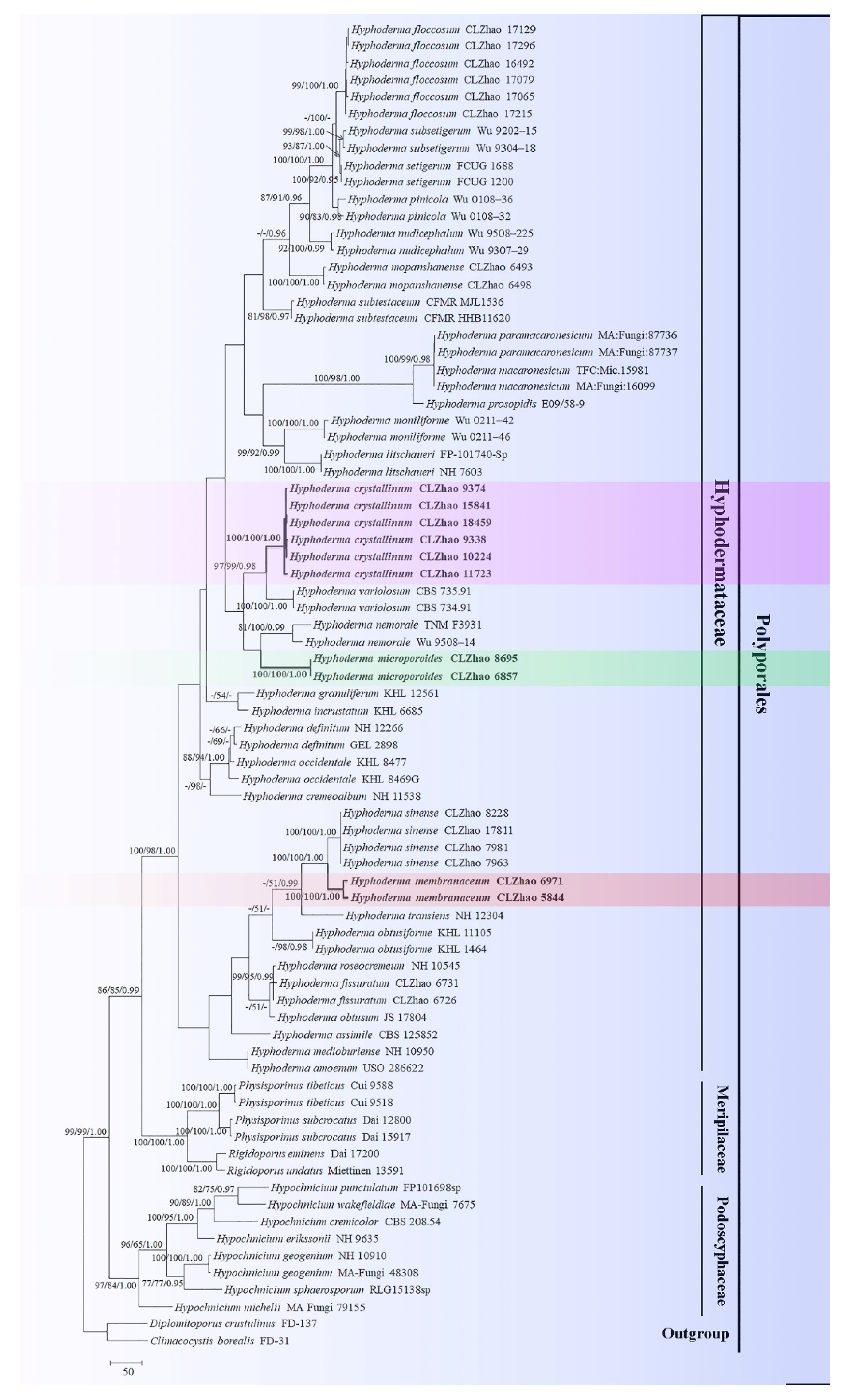
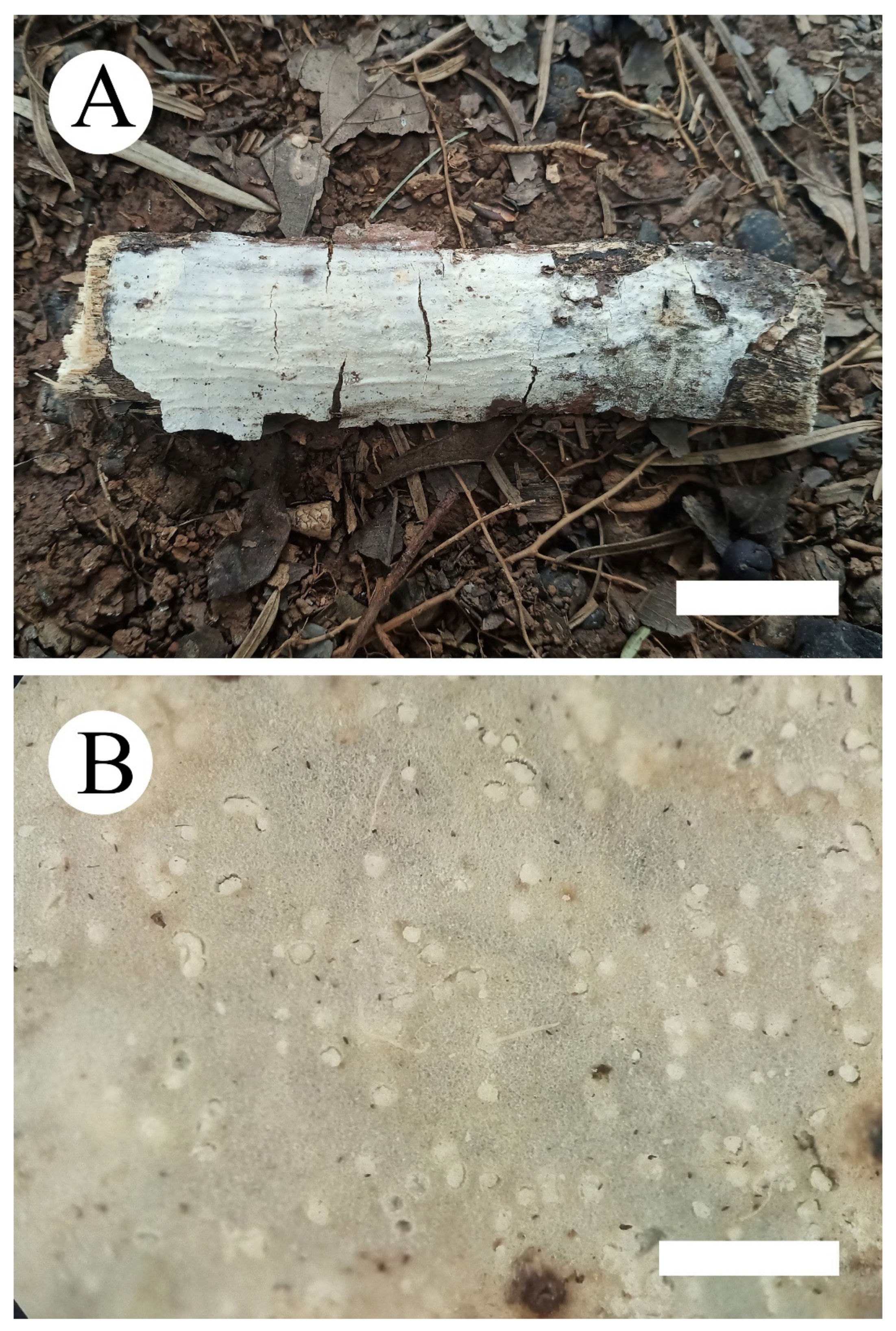
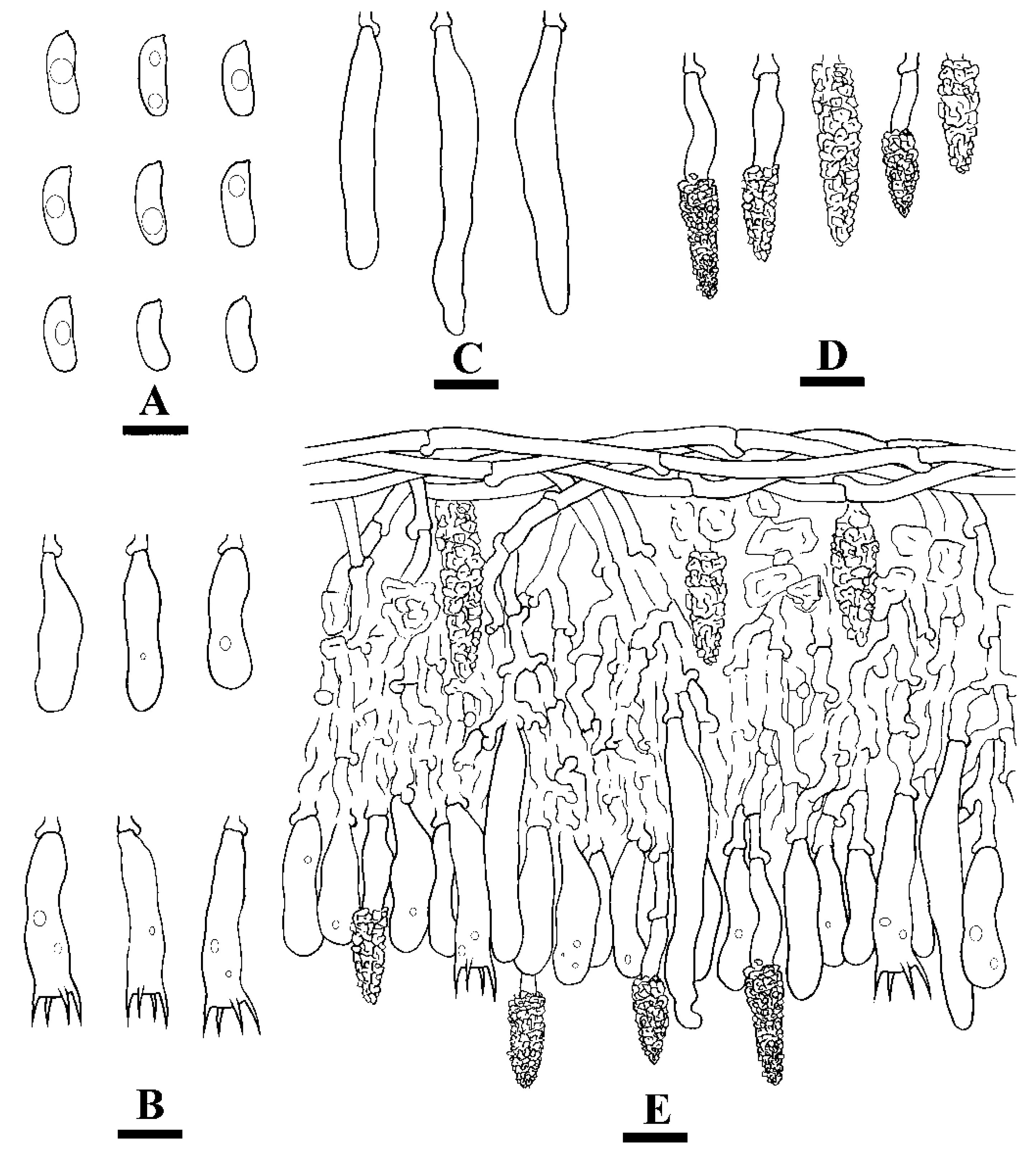
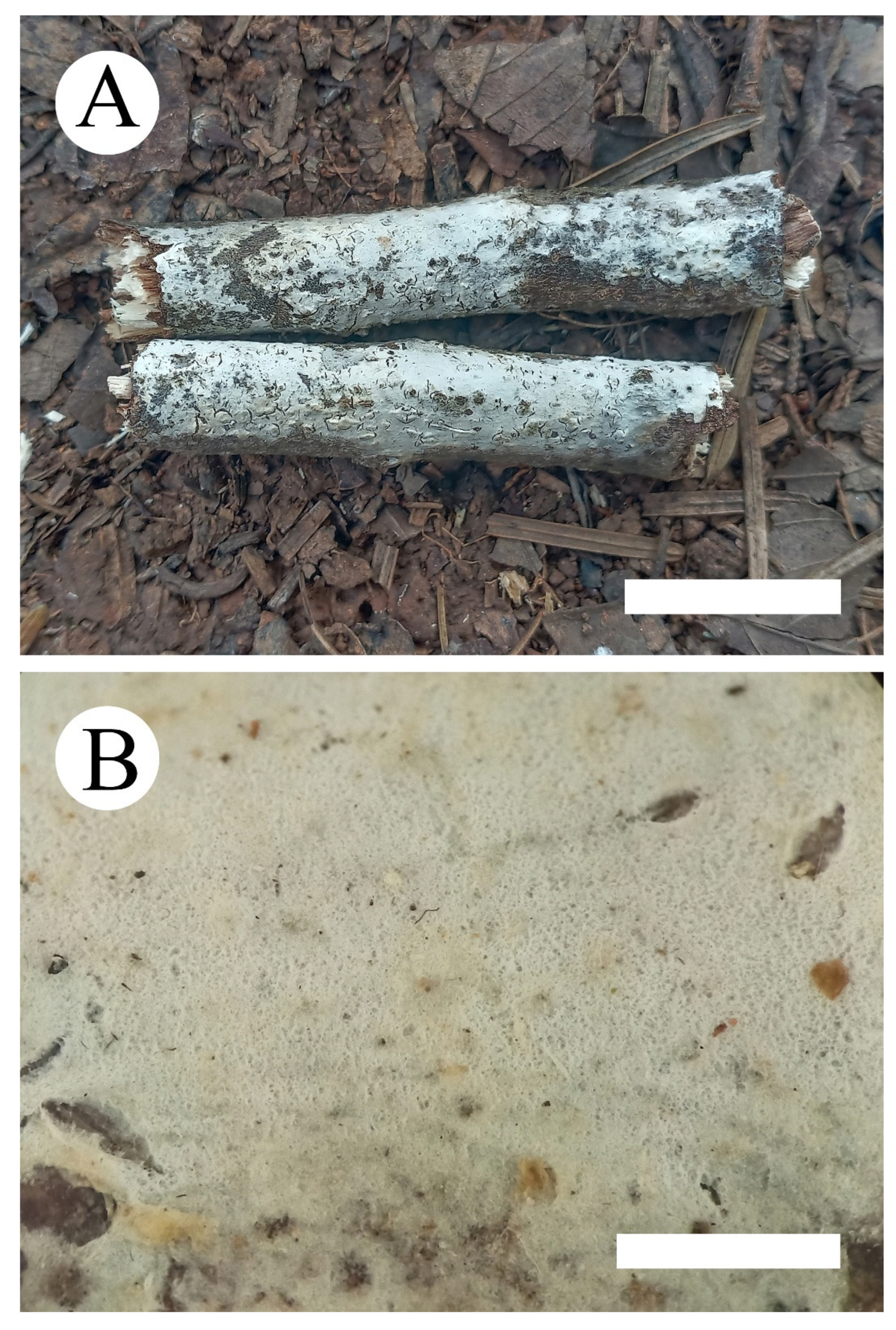
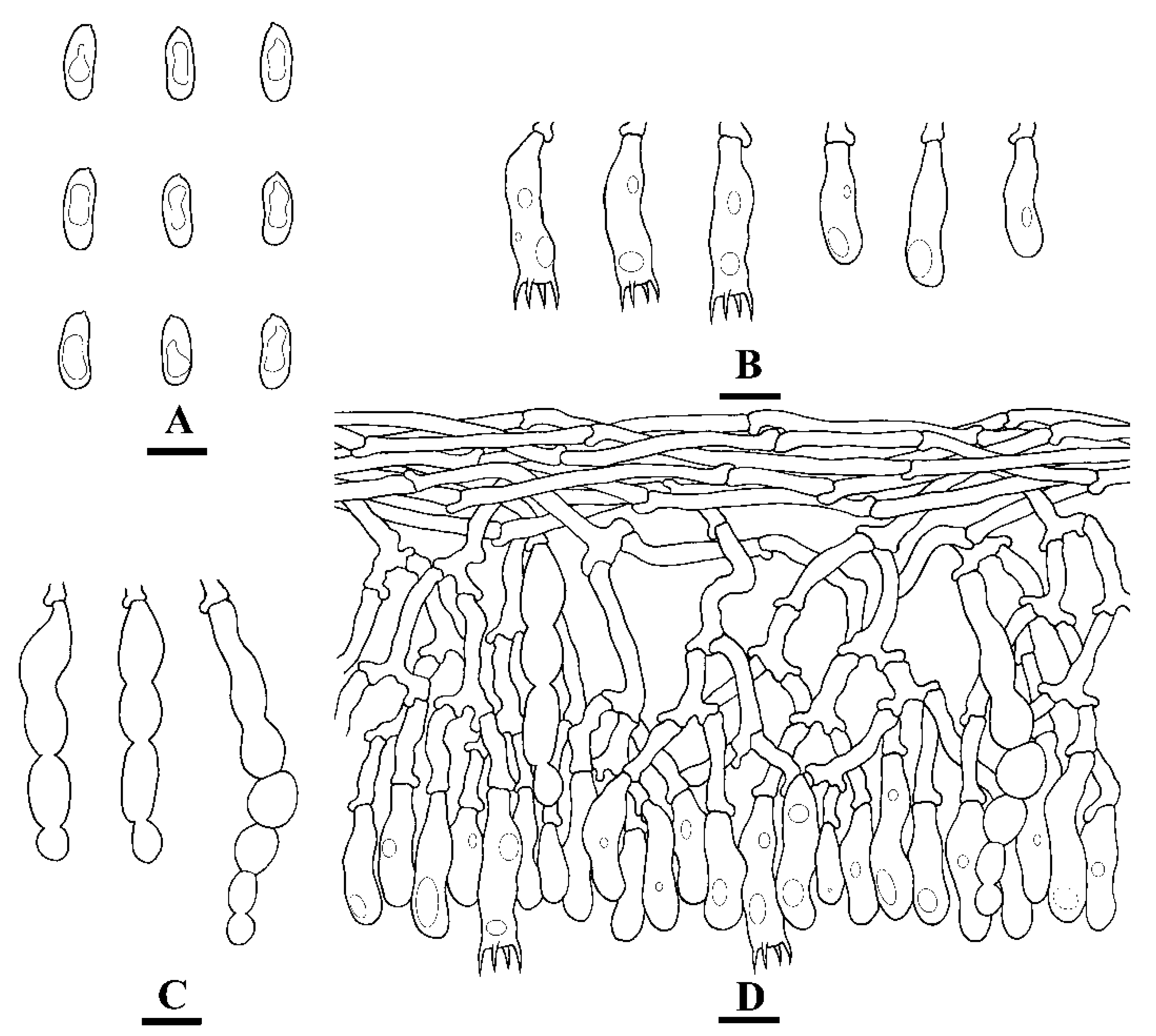
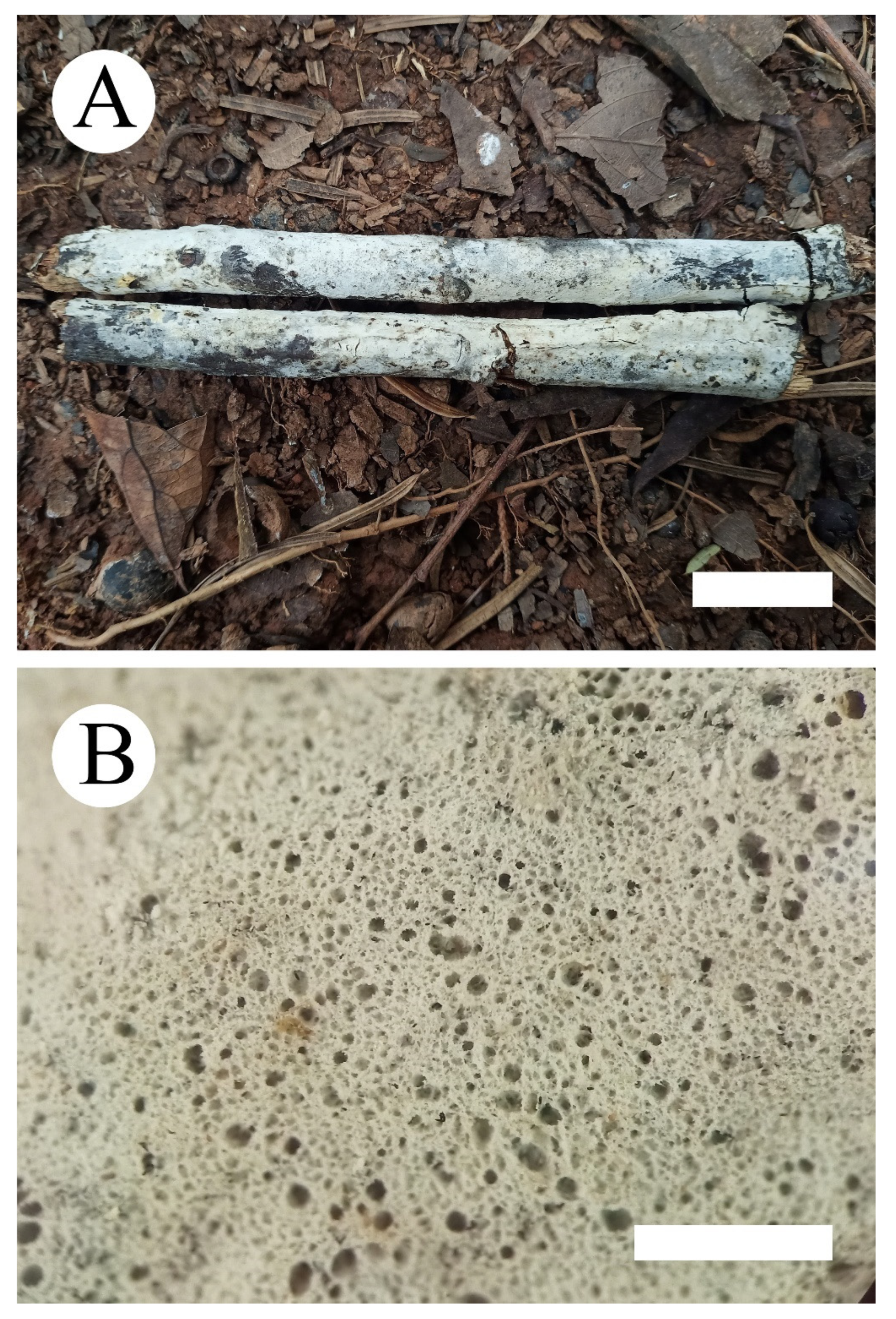
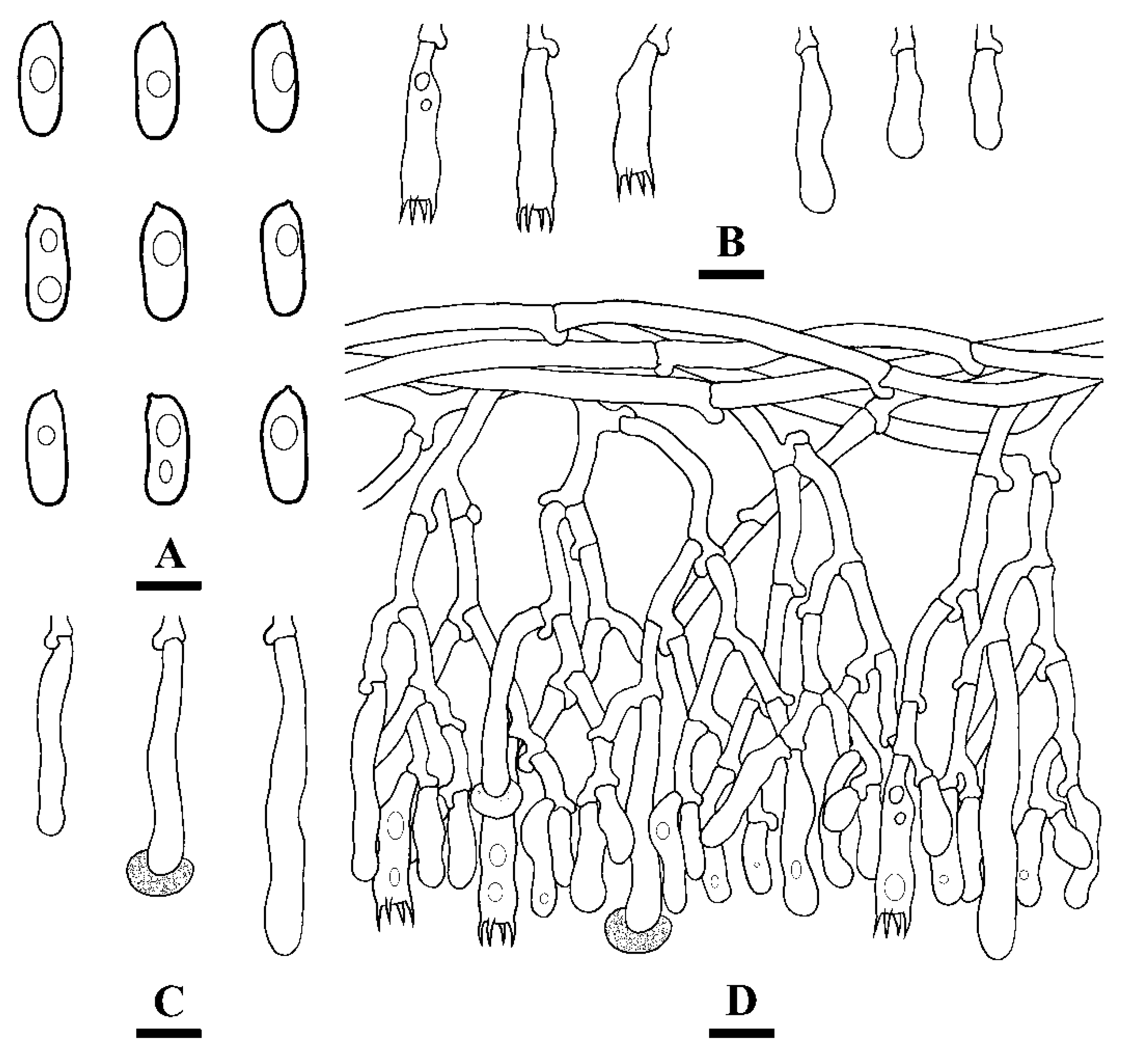
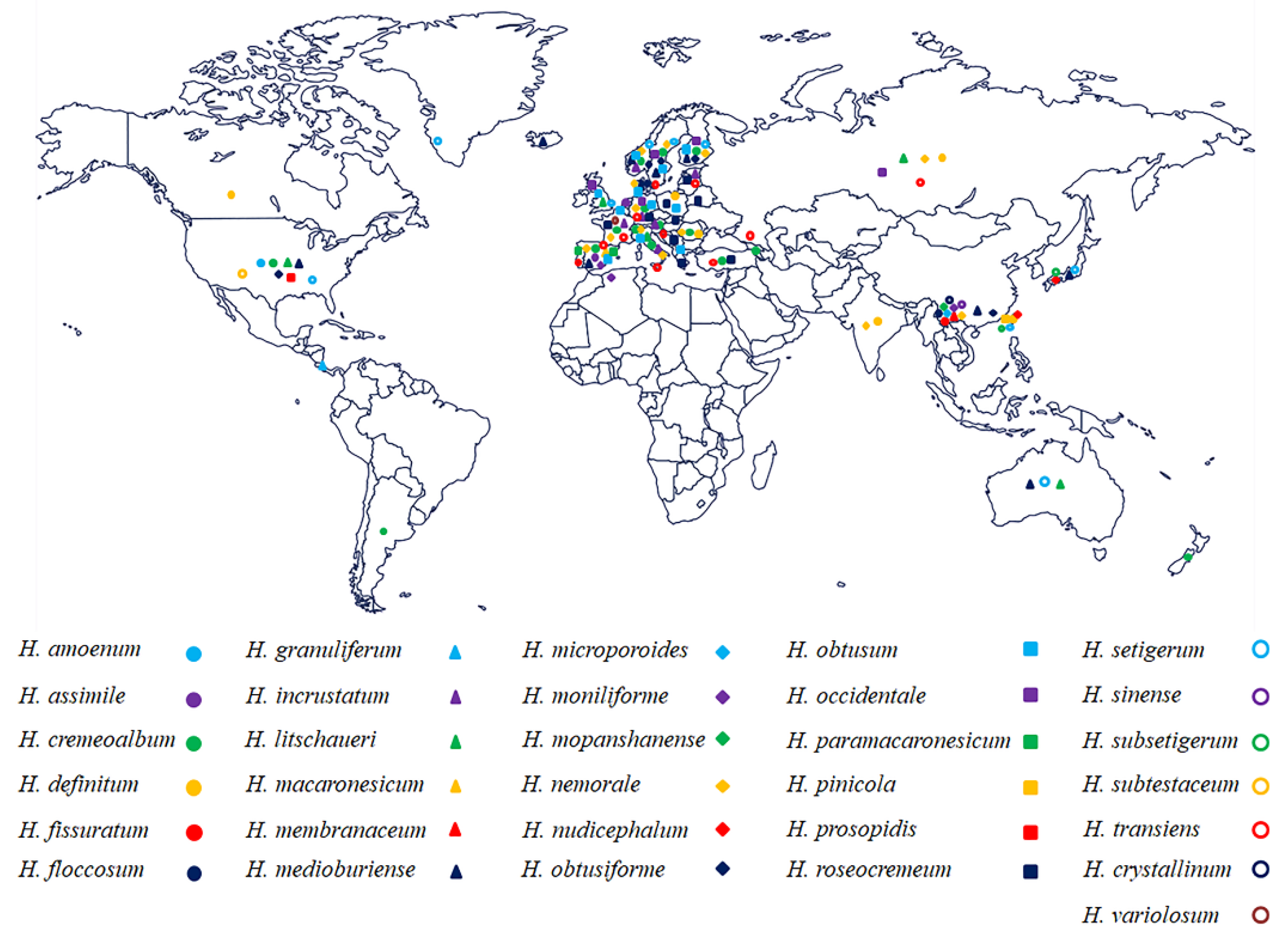
| Species Name | Specimen No. | GenBank Accession No. | References | |
|---|---|---|---|---|
| ITS | LSU | |||
| Climacocystis borealis | FD-31 | KP135308 | KP135210 | [19] |
| Diplomitoporus crustulinus | FD-137 | KP135299 | KP135211 | [19] |
| Hyphoderma amoenum | USO 286622 | HE577030 | [17] | |
| H. assimile | CBS 125852 | MH863808 | MH875272 | [24] |
| H. cremeoalbum | NH 11538 | DQ677492 | DQ677492 | [16] |
| H. crystallinum | CLZhao 9338 | MW917161 | MW913414 | Present study |
| H. crystallinum | CLZhao 9374 | MW917162 | MW913415 | Present study |
| H. crystallinum | CLZhao 10224 | MW917163 | MW913416 | Present study |
| H. crystallinum | CLZhao 11723 | MW917164 | MW913417 | Present study |
| H. crystallinum | CLZhao 15841 | MW917165 | MW913418 | Present study |
| H. crystallinum | CLZhao 18459 | MW917166 | MW913419 | Present study |
| H. definitum | GEL 2898 | AJ406509 | [18] | |
| H. definitum | NH 12266 | DQ677493 | DQ677493 | [16] |
| H.fissuratum | CLZhao 6731 | MT791331 | MT791335 | [15] |
| H.fissuratum | CLZhao 6726 | MT791330 | MT791334 | [15] |
| H. floccosum | CLZhao 17129 | MW301683 | MW293733 | [25] |
| H. floccosum | CLZhao 17296 | MW301686 | MW293736 | [25] |
| H. floccosum | CLZhao 16492 | MW301688 | MW293734 | [25] |
| H. floccosum | CLZhao 17215 | MW301687 | MW293735 | [25] |
| H. floccosum | CLZhao 17079 | MW301685 | [25] | |
| H. floccosum | CLZhao 17065 | MW301684 | [25] | |
| H. granuliferum | KHL 12561 | JN710545 | JN710545 | [18] |
| H. incrustatum | KHL 6685 | AY586668 | [18] | |
| H. litschaueri | NH 7603 | DQ677496 | DQ677496 | [16] |
| H. litschaueri | FP-101740- sp | KP135295 | KP135219 | [26] |
| H. macaronesicum | MA:Fungi:16099 | HE577027 | [18] | |
| H. macaronesicum | TFC:Mic.15981 | HE577028 | [18] | |
| H. medioburiense | NH 10950 | DQ677497 | DQ677497 | [16] |
| H. membranaceum | CLZhao 5844 | MW917167 | MW913420 | Present study |
| H. membranaceum | CLZhao 6971 | MW917168 | MW913421 | Present study |
| H. microporoides | CLZhao 6857 | MW917169 | MW913422 | Present study |
| H. microporoides | CLZhao 8695 | MW917170 | MW913423 | Present study |
| H. moniliforme | Wu 0211-42 | KC928282 | KC928283 | [27] |
| H. moniliforme | Wu 0211-46 | KC928284 | KC928285 | [27] |
| H. mopanshanense | CLZhao 6498 | MT791329 | MT791333 | [15] |
| H. mopanshanense | CLZhao 6493 | MT791328 | MT791332 | [15] |
| H. nemorale | TNM F3931 | KJ885183 | KJ885184 | [27] |
| H. nemorale | Wu 9508-14 | KC928280 | KC928281 | [27] |
| H. nudicephalum | Wu 9307-29 | AJ534269 | [28] | |
| H. nudicephalum | Wu 9508-225 | AJ534268 | [28] | |
| H. obtusiforme | KHL 1464 | JN572909 | [29] | |
| H. obtusiforme | KHL 11105 | JN572910 | [29] | |
| H. obtusum | JS 17804 | AY586670 | [29] | |
| H. occidentale | KHL 8469 | AY586674 | [29] | |
| H. occidentale | KHL 8477 | DQ677499 | DQ677499 | [16] |
| H. paramacaronesicum | MA:Fungi:87736 | KC984399 | KF150074 | [14] |
| H. paramacaronesicum | MA:Fungi:87737 | KC984405 | KF150073 | [14] |
| H. pinicola | Wu 0108-32 | KJ885181 | KJ885182 | [29] |
| H. pinicola | Wu 0108-36 | KC928278 | KC928279 | [29] |
| H. prosopidis | E09/58-9 | HE577029 | [29] | |
| H. roseocremeum | NH 10545 | AY586672 | [29] | |
| H. setigerum | FCUG 1200 | AJ534273 | [28] | |
| H. setigerum | FCUG 1688 | AJ534272 | [28] | |
| H. sinense | CLZhao 7963 | MW301679 | MW293730 | [25] |
| H. sinense | CLZhao 17811 | MW301682 | MW293732 | [25] |
| H. sinense | CLZhao 8228 | MW301681 | [25] | |
| H. sinense | CLZhao 7981 | MW301680 | MW293731 | [25] |
| H. subsetigerum | Wu 9304-18 | AJ534277 | [28] | |
| H. subsetigerum | Wu 9202-15 | AJ534278 | [28] | |
| H. subtestaceum | HHB11620 | GQ409521 | [29] | |
| H. subtestaceum | CFMR MJL1536 | GQ409522 | [29] | |
| H. transiens | NH 12304 | DQ677504 | DQ677504 | [16] |
| H. variolosum | CBS 734.91 | MH862320 | MH873992 | [24] |
| H. variolosum | CBS 735.91 | MH862321 | MH873993 | [24] |
| Hypochnicium cremicolor | CBS 208.54 | MH857294 | MH868826 | [24] |
| H. erikssonii | NH 9635 | DQ677508 | DQ677508 | [16] |
| H. geogenium | NH 10910 | DQ677509 | DQ677509 | [16] |
| H. geogenium | MA-Fungi 48308 | FN552534 | JN939576 | [30] |
| H. michelii | MA-Fungi 79155 | NR119742 | NG060635 | [30] |
| H. punctulatum | FP101698sp | KY948827 | KY948860 | [19] |
| H. sphaerosporum | RLG15138sp | KY948803 | KY948861 | [19] |
| H. wakefieldiae | MA-Fungi 7675 | FN552531 | JN939577 | [30] |
| Physisporinus subcrocatus | Dai 15917 | KY131870 | KY131926 | [31] |
| P. subcrocatus | Dai 12800 | KY131869 | KY131925 | [31] |
| P. tibeticus | Cui 9588 | KY131873 | KY131929 | [31] |
| P. tibeticus | Cui 9518 | KY131872 | KY131928 | [31] |
| Rigidoporus eminens | Dai 17200 | MT279690 | MT279911 | [31] |
| R. undatus | Miettinen-13591 | KY948731 | KY948870 | [19] |
Publisher’s Note: MDPI stays neutral with regard to jurisdictional claims in published maps and institutional affiliations. |
© 2021 by the authors. Licensee MDPI, Basel, Switzerland. This article is an open access article distributed under the terms and conditions of the Creative Commons Attribution (CC BY) license (https://creativecommons.org/licenses/by/4.0/).
Share and Cite
Guan, Q.-X.; Zhao, C.-L. Taxonomy and Phylogeny of the Wood-Inhabiting Fungal Genus Hyphoderma with Descriptions of Three New Species from East Asia. J. Fungi 2021, 7, 308. https://doi.org/10.3390/jof7040308
Guan Q-X, Zhao C-L. Taxonomy and Phylogeny of the Wood-Inhabiting Fungal Genus Hyphoderma with Descriptions of Three New Species from East Asia. Journal of Fungi. 2021; 7(4):308. https://doi.org/10.3390/jof7040308
Chicago/Turabian StyleGuan, Qian-Xin, and Chang-Lin Zhao. 2021. "Taxonomy and Phylogeny of the Wood-Inhabiting Fungal Genus Hyphoderma with Descriptions of Three New Species from East Asia" Journal of Fungi 7, no. 4: 308. https://doi.org/10.3390/jof7040308
APA StyleGuan, Q.-X., & Zhao, C.-L. (2021). Taxonomy and Phylogeny of the Wood-Inhabiting Fungal Genus Hyphoderma with Descriptions of Three New Species from East Asia. Journal of Fungi, 7(4), 308. https://doi.org/10.3390/jof7040308







